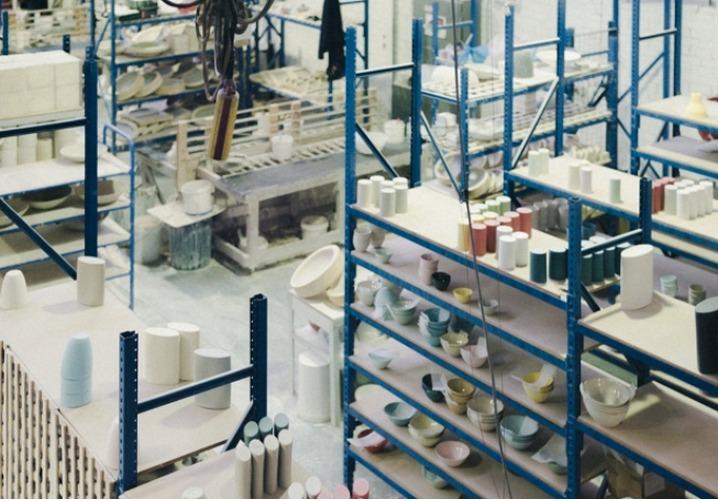Published in Broadsheet, Summer print issue December 2012
We visit the Mud Australia workshop to chat with owners Shelley Simpson and James Kirton about their impeccable ability to do one thing well.
It’s common knowledge that a badly designed jug is guaranteed to make you spill. But for Shelley Simpson, the founder of celebrated ceramics company Mud Australia, design flaws are no match for a steady hand and an unwavering focus. “It’s a confidence thing,” she says. “The second you lose confidence when you’re pouring something, it just drips everywhere.”
Located in Sydney’s Marrickville, Mud Australia’s studio and production facility is the physical manifestation of Simpson’s wisdom. Everywhere you look, workers spin jugs, bowls, plates and platters out of lumps of clay, moving to a rhythm that is both understated and urgent.
A woman meticulously applies colour to a container of porcelain slip. Later, her efforts will come to life in velvety pinks, earthy greens and sky blues – a colour palette that has seduced everyone from David Chang of Momofuku fame and Australian chef Bill Granger to discerning stylists, home cooks and dinner party enthusiasts.
In many ways, the space strikes the balance between artisanship and mass production – conflicting values that have seen the brand evolve from a one-woman operation founded in a Surry Hills terrace 18 years ago, to a design success story with a global wholesale presence and stores in Sydney, Melbourne and New York.
“The idea was born when I moved into a house with a woman who had a kick wheel in her backyard,” recalls Simpson. “She went to the Blue Mountains for the weekend and encouraged me to have a go and I discovered I really liked throwing clay by hand and hand-painting what I created.
“I wasn’t sure what I was doing in terms of a career and a lot of the things I was trying, I wasn’t achieving. I thought it was time that I did my own thing.”
Simpson initially went into partnership with her then housemate, but that soon changed. “I was always supported by James who is my life partner as well,” Simpson pauses to glance at James Kirton, who co-runs the business. There’s something inspiring about the apparent energy between them, an affinity that seems a silent catalyst in Mud’s success.
Then, of course, there’s Simpson’s tenacity and sharp design instinct – attributes she owes not to art school but to her work ethic and willingness to do whatever it took to make Mud work.
“Finding the Mud look took three years,” she says. “Up until then, we were just doing whatever we could to pay the rent. We had a few interesting meetings with retail stores and asked them what they were looking for. At the time, a lot of people were talking about simplicity and colour. We just evolved from there.”
As far as creative ambitions go, a focus on simplicity and colour may seem relatively modest, but in the case of Mud, it has helped blur the line between ceramics and art. Whether you’re looking at a classic, oval platter or tall, peaked jug, every piece is both distinctly sculptural and highly tactile – equally worthy of being collected or for every day use.
“The range hasn’t changed too much and we’ve kept production processes the same since the beginning. We’ve just added or removed various colours and shapes seasonally,” says Kirton.
“Each piece is timeless and quite emotional – simple shapes with touch marks that remain. People who own Mud pieces understand that it’s an emotional product and have a strong connection with it.”
Simpson and Kirton are firm believers in the accessibility of design and cite iconic American designer Russel Wright as a major inspiration. Unsurprisingly, every piece is microwave and dishwasher safe.
“I think Wright said that, ‘good design is for everyone’,” Kirton offers. In the case of Mud, it’s a commitment that has paid off in spades.
